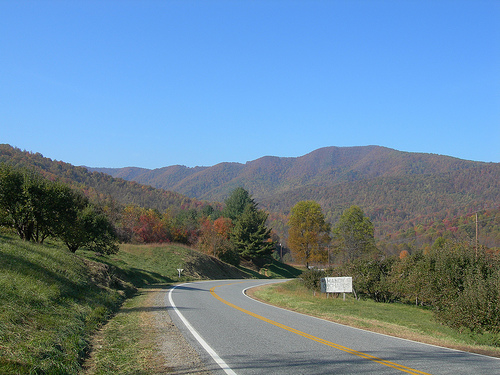Virginia Town Exemplifies White Space Usage
CLAUDVILLE, VA.: The community of Claudville, Va., is quintessentially “unserved,” an archetype for using TV spectrum for wireless broadband. The town of 900 people sits on the rugged and forested edge of the Blue Ridge, in the sparsely populated territory of Southwestern Virginia. In surrounding Patrick County, pictured left, there are an average of 20 houses per square mile. Per capital income is $15,574.
Internet access is limited, and up until a couple of years ago, it was entirely nonexistent.
“We have been working for many years to help the people of Claudville get high-speed data services that urban areas take for granted,” said Roger Hayden, director of Claudville Computer Center and the Patrick County Broadband Task Force.
Hayden and his colleagues realized success. Claudville hit the headlines this week when Rep. Rick Boucher (D-Va.) announced the launch of an experimental white-space broadband network in the community.
The Claudville experiment represents the first use of unoccupied TV channels for full-time, non-broadcast communications. The local high school, a cafe, a fish hatchery and a community center were outfitted with computers to take advantage of the area’s first real broadband access. TDF Foundation, a Washington, D.C. venture cap-fund, helped build the facilities. Spectrum Bridge, a private company in Lake Mary, Fla., designed the network and is in charge of monitoring it for interference.
White spaces, once known as “taboo” TV channels, are the most hotly sought-after properties in all of radio frequency spectrum. Demand for spectrum intensified with the explosion of cell-phone use. And now that TV is all-digital, the taboo channels once left open to prevent signal interference are considered fair game.
Microsoft and Dell were two of the first and most powerful advocates for using white spaces for broadband communications. Both supplied technology for the Claudville network, which was launched on a single frequency under an 18-month experimental license from the FCC.
Both computer giants, along with Google, pushed to launch devices in the unused TV channels without having to license them with the FCC. The commission agreed to the arrangement--marking the first time an entity has been granted the unlicensed use of U.S. radio frequency spectrum. Those devices are still in the prototype stage. Indeed, Microsoft was recently granted an experimental license to test its prototypes in the Redmond, Wash. area. (See “FCC Grants Microsoft White Space Licenses”)
In Claudville, connectivity is supplied through WiFi access points. The white space frequency is used for backhaul only, so the network is not yet ready for household deployment.
The primary concern of broadcasters is signal interference. Broadcast engineers, including Charles Rhodes, who ran the technical arm of the Advanced Television Testing Lab, noted that digital TV signals required a buffer zone (à la taboo channels) as much as did analog signals. Digital reception was--and still is--being worked out.
The TV stations serving Claudville are all miles away. WDBJ-TV, the CBS affiliate, and WSLS-TV, the NBC, are out of Roanoke, Va., 54 miles north-northeast. WXII-TV, another NBC, and WGHP-TV, a Fox, are out of Winston-Salem, N.C. 35 miles south.
Peter Stanforth, chief technology officer of Spectrum Bridge, said no interference has yet been identified.
If it is, it will be relatively easy to trace because of the fixed operations of the network. Interference from mobile devices will be much more difficult to pint down, but they’re supposed to sniff out spectrum occupied by TV channels and jump to unused ones. The Claudville system relies on a database compiled by Spectrum Bridge from FCC licensing information.
Dave Donovan, chief of the Association of Maximum Service Television, said it’s crucial for that information to be correct.
“We’ve always said we support using spectrum in rural areas to be used for broadband, but it requires an accurate database,” he said. “Our biggest concern there was that the spectrum they’re using does not interfere with over-the-air television.”
Over-the-air television is considered by some to be a waste of spectrum. Nearly 80 percent of TV households in the county opt to pay for piped-in programming. Wireless broadband seems a better use for the TV spectrum, particularly in communities like Claudville.
“Our students and teachers did not have access to computers or broadband connectivity until now,” said Jerry Whitlow, administrator of Trinity Christian School said.
On Capitol Hill, Boucher thanked everyone involved with launching the Claudville system, including a Republican and a Democratic FCC commissioner. The tiny town represents an inroad into the TV spectrum, as well as a presidential charter.
President Barack Obama charged FCC Chairman Julius Genachowski to make nationwide broadband access his singular goal. Genachowski and the FCC today established rules to keep Internet service providers from controlling traffic on the Web, under what’s known as “network neutrality.” His deputy, Blair Levin, is reported to be pitching broadcasters on giving up their spectrum for a split of auction fees, though such a scheme would have to make it past the likes of Sen. John McCain (R-Ariz.) widely considered a long-time and vociferous detractor of the broadcast industry.
Meanwhile, students in Claudville’s Trinity High School are surfing the Web on TV channels.
-- Deborah D. McAdams
(Image by Jimmy Emerson)

The professional video industry's #1 source for news, trends and product and tech information. Sign up below.
